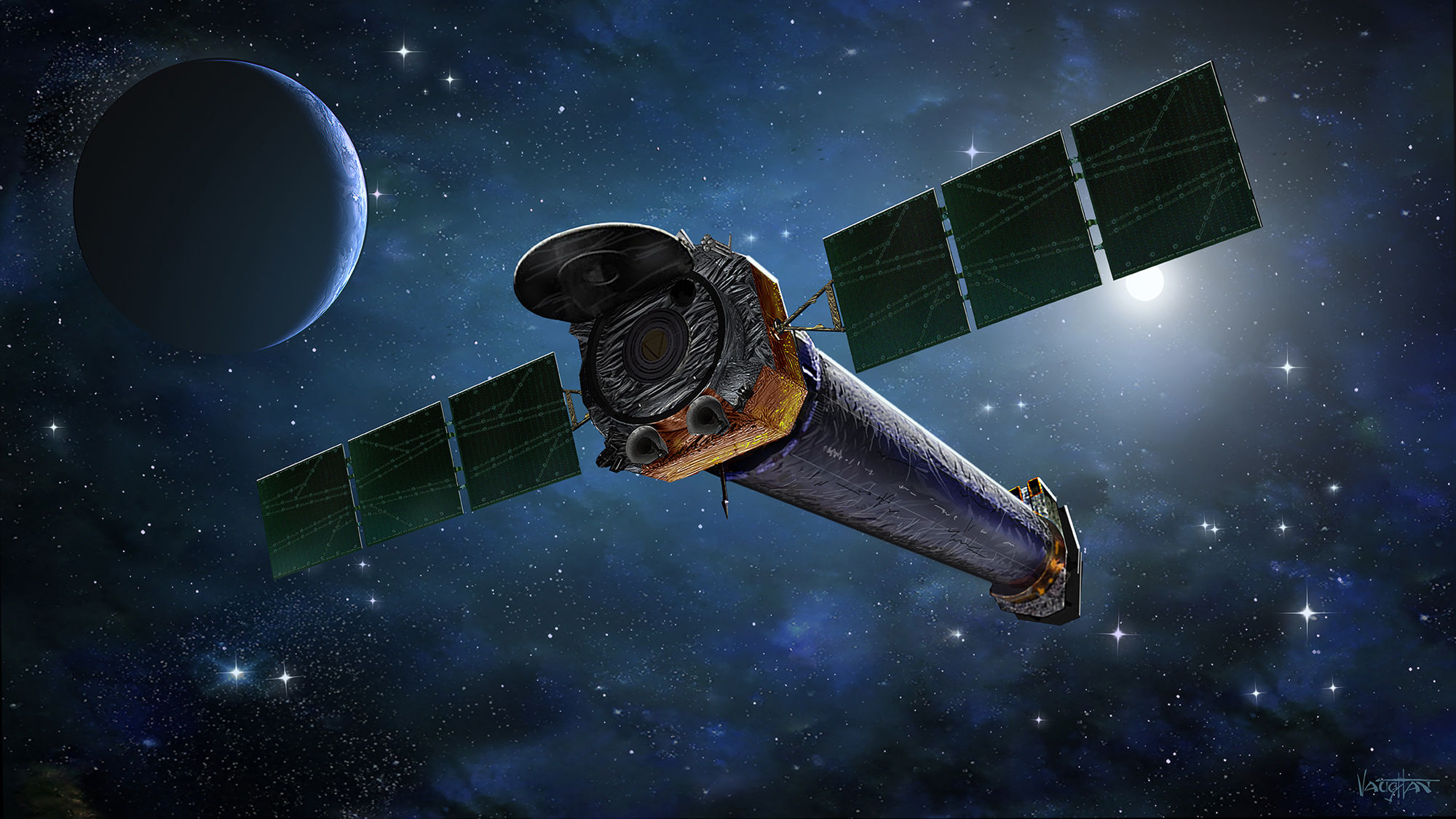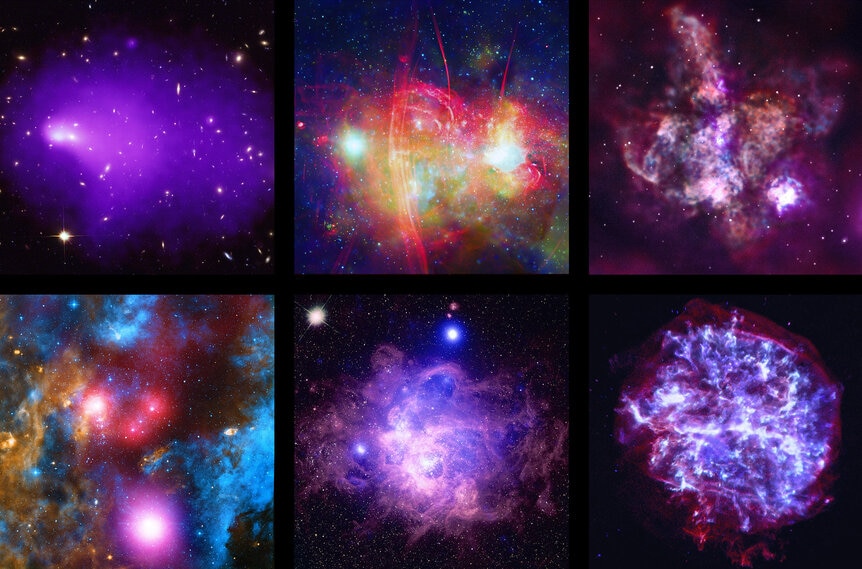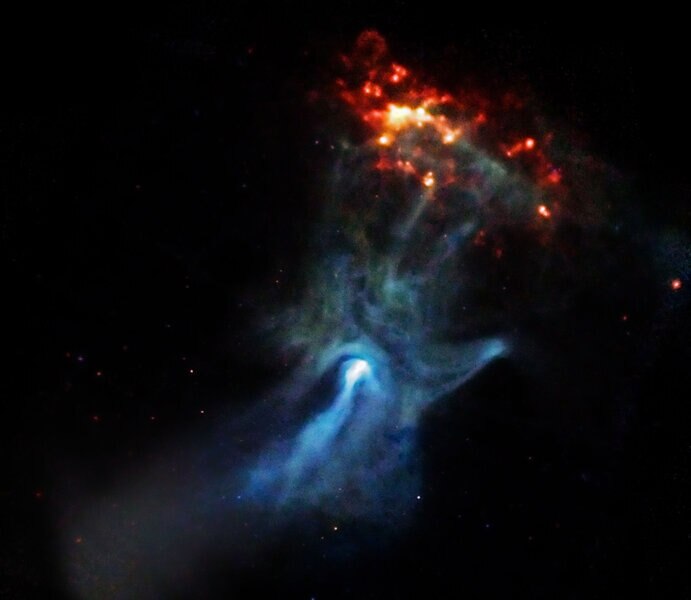Create a free profile to get unlimited access to exclusive videos, sweepstakes, and more!
20 years in space for astronomers’ X-ray eye on the sky: Chandra

On July 23, 1999, the Space Shuttle Columbia roared off the launch pad, thundering into orbit. On board was the heaviest payload ever lofted by a Shuttle, totaling over 22 tons. The vast majority of this was taken up by a single satellite: the Chandra X-ray Observatory (plus a two-stage rocket to carry it to its proper orbit once deployed off of Columbia).
That was 20 years ago yesterday ... so happy anniversary, Chandra! And to the huge team of people who designed it, built it, launched it, and have subsequently used it to explode our knowledge of the Universe in X-rays. We’ve learned a lot in the past two decades.
X-rays are a form of light, a very high-energy form. It takes a lot of energy to make an X-ray, so in general they are emitted by extremely violent processes: exploding stars, black holes gobbling down matter, stars flaring as their powerful magnetic fields twist up and snap, huge shock waves ramming through gas in space, colliding galaxies slamming together clouds of gas to create waves of star formation … you know, that sort of thing.
X-rays are absorbed by Earth’s atmosphere, so if you want to see them you have to go up, up, and away, high above the air. In Chandra’s case, after being deployed by Columbia, the two-stage rocket sent it into an elliptical orbit that takes it from 14,000 to over 130,000 km from Earth — a third of the way to the Moon! Once there, and after a shakedown cruise that lasted about a month, it started taking astronomical data. It hasn’t really stopped since, and is the longest-running astronomical satellite in the fleet that hasn’t needed upgrades or repairs. Incredible.
To celebrate this bidecadal achievement, the folks at the Chandra X-ray Center in Cambridge, Massachusetts, released a lovely collection of images the observatory has taken:
Pretty, eh? I was going to write up something about each one, but you know what? I’m not going to, for two reasons: 1) The folks at CXC already did, so go there and read what they have to say, and b) while those are all awesome, none is my actual favorite Chandra image of all time.
So what is?
Why, this:
Seriously, how cool is that? It looks like a giant ghostly hand reaching for some sort of cosmic object, purpose unknown. Even better: The shapes of the fingers and the wrist make them look like bones, and this is an X-ray image*!
But in reality this decidedly odd image shows what happens when a massive star explodes but doesn’t quite want to die. The outer layers of the star scream outward at a good fraction of the speed of light, but the core of the star collapses. If the core is massive enough (more than about 3 times the mass of the Sun) it forms a black hole, but if it’s less than that (from about 1.4 to 2.8 times the Sun’s mass) it forms a seriously dense neutron star. This has the mass of more than the Sun crammed into a ball just a few kilometers across! A cube of neutron-star-stuff a centimeter on a side weighs about the same as all the cars in the United States combined. So, yeah.
What you see in this image is from a neutron star called B1509-58 — it’s embedded in the bright clot of material making up the wrist structure. B1509 is roughly 17,000 light years away from Earth, and the star that formed it exploded roughly 6,000 – 20,000 years ago (though there are some estimates it might be less than 2,000 years old). Newly born neutron stars spin rapidly, and B1509 rotates roughly 7 times per second. It also has a very strong magnetic field, and due to complicated physics (weasel words for “we’re not really sure how this works exactly”) it focuses twin beams of matter and energy that shoot out of the poles of the neutron star.
This gets better: The neutron star can wobble, as a toy top spinning on a table wobbles as it slows. This is called precession, and is usually due to some outside force tugging on the spinning object. Perhaps B1509 has a companion like a faint star orbiting it, yanking on it due to gravity.
Over time, this means the jets shooting away change direction. The jets slam into material around them, creating the long fingers, and there are multiple fingers due to the motion of the jets’ precession.
The red gas above the hand is left over from the supernova explosion. When the jet slams into that stuff it creates a hot spot, and as it moves it makes lots of them. So every bright dot you see in that gas is where material screaming away from the neutron star is crashing into the gas!
Perhaps you’re getting a sense of why to this day (the image was taken in 2009) this is still my favorite Chandra image. Even if it weren’t chock full o’ amazing science and mind-crushing power, the shape of the structures themselves are just incredible.
But just because this is my favorite doesn’t mean I don’t love many more. I’ve written about a lot of them, so I suggest perusing the “Chandra X-ray Observatory” tag to see some of them. When your job is to look for X-rays from space, pretty much everything you see is going to be astonishing. Chandra delivers.
So again, my hearty congratulations to everyone who contributed to this mammoth X-ray observatory’s mission to scan the high-energy cosmos. Happy anniversary, and may there be many, many more to come.
* When you take a medical X-ray of a body part, the photons pass through your soft tissue but are absorbed by bones (the calcium in bones is pretty efficient at this). The image generated really shows shadows, where the X-rays don’t get through, so in a sense they’re negatives. In astronomical X-ray images you’re seeing the actual photons themselves detected by the instrument, so it’s a positive image. This reminds me of something that's always bugged me about Superman’s X-ray vision; if he can see inside an object, where do the X-rays come from, and what’s being used as a detector? You need a source of X-rays on one side of the object and a detector on the other. Superman’s Kryptonian eyeballs can’t do both. I know that “X-ray vision” may be a nickname for some other process that allows him to see inside things, but still the geometry doesn’t work. I have other objections, so maybe at some point I’ll write them up in my newsletter.





























